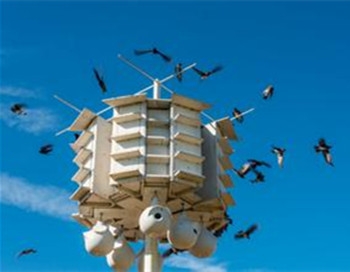
Where purple martins had once laid their eggs in hollow threes, in time, they came to rely almost totally on people to provide nests for them.
北美洲紫燕曾在這些中空的大樹中下蛋,而現在,他們基本上完全依賴于人們為他們建造的巢穴。
These artificial nests were made from dried out squashes known as gourds. The shape made them perfect nesting sites for these birds. But what triggered this special relationship in the first place? It’s possible the insect-eating martins helped to control pests living around Native American camps. Whatever the original reason, the traditional tie between people and purple martins survives to this day. But now, in keeping with the modern world, hollow gourds have often been replaced by high-rise apartment blocks.
這些人造巢穴是由風干的葫蘆制造的。葫蘆的形狀使葫蘆成為這些鳥兒下蛋的最佳場所。但是,人類和北美洲紫燕最初是怎樣建立起這樣一種特殊的關系呢?答案可能是這些紫燕捕食昆蟲,幫助了美洲土著居民控制營地周圍的昆蟲數量。不管最初的原因是什么,人類與紫燕這樣的一種傳統關系一直持續至今。但是如今,為了與時俱進,中空的葫蘆被一些聳立的,并具有現代建筑風格的鳥巢所取代。
This special relationship between purple martins and people is one of the few in North America to cross cultural boundaries between native groups and European settlers. Other animals to cross this cultural divide did so for different reasons.
人類與紫燕這樣的一種特殊關系僅是北美本土種族和歐洲外來者的文化交融關系之一。而其他跨越文化差異的動物選擇這么去做也是有不同原因的。
More than 50 million wild turkeys were living in North America when the first Europeans arrived. They were occasionally hunted by the native people, but the European settlers had a taste for turkey and they took this to extremes. As hunting intensified, wild turkey populations plummeted.
在第一批歐洲人來到北美時,北美有五千多萬只野生火雞。它們時常被當地人捕食,但是歐洲人對火雞情有獨鐘,因此他們吃火雞極為頻繁,隨著捕殺的加劇,野生火雞數量急劇下降。
The turkey became a central part of Thanksgiving Day celebrations and was almost hunted to extinction.
火雞也是感恩節慶祝的核心菜肴,當時由于被捕殺,幾乎滅絕。
英文文本來自普特英語,譯文屬可可原創,僅供學習交流使用,未經許可不得轉載。











